Roses are generally grouped into categories. For many years there were seven commonly recognized rose categories: hybrid teas, floribundas, grandifloras, miniature roses, climbers, old-fashioned roses, and shrub roses. More recently, as roses have become more widely grown and their history understood, rose categories have expanded.
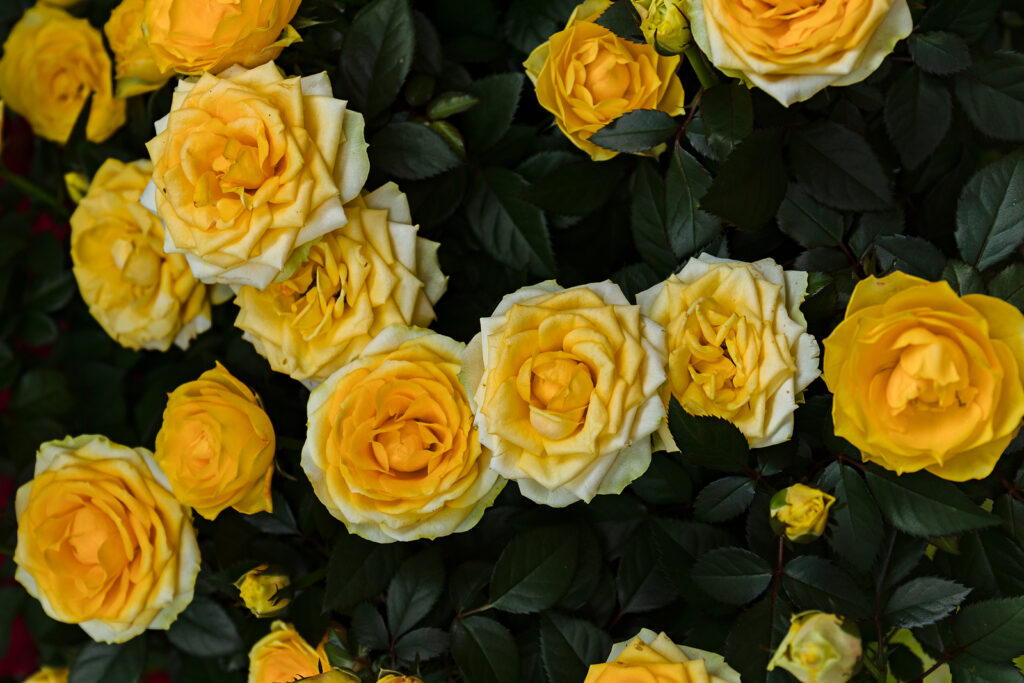
Old Roses and Modern Roses
There are two broad categories of roses and many subcategories. The two broad categories are old roses and modern roses.
A modern rose is a rose that has evolved since 1867. That is the universally accepted date for the first hybrid tea rose.
An old garden rose is a rose that belongs to a classification that existed before 1867. (Old garden roses are also known as antique roses, heirloom roses, old-fashioned roses, old roses, or “grandma’s roses”.)
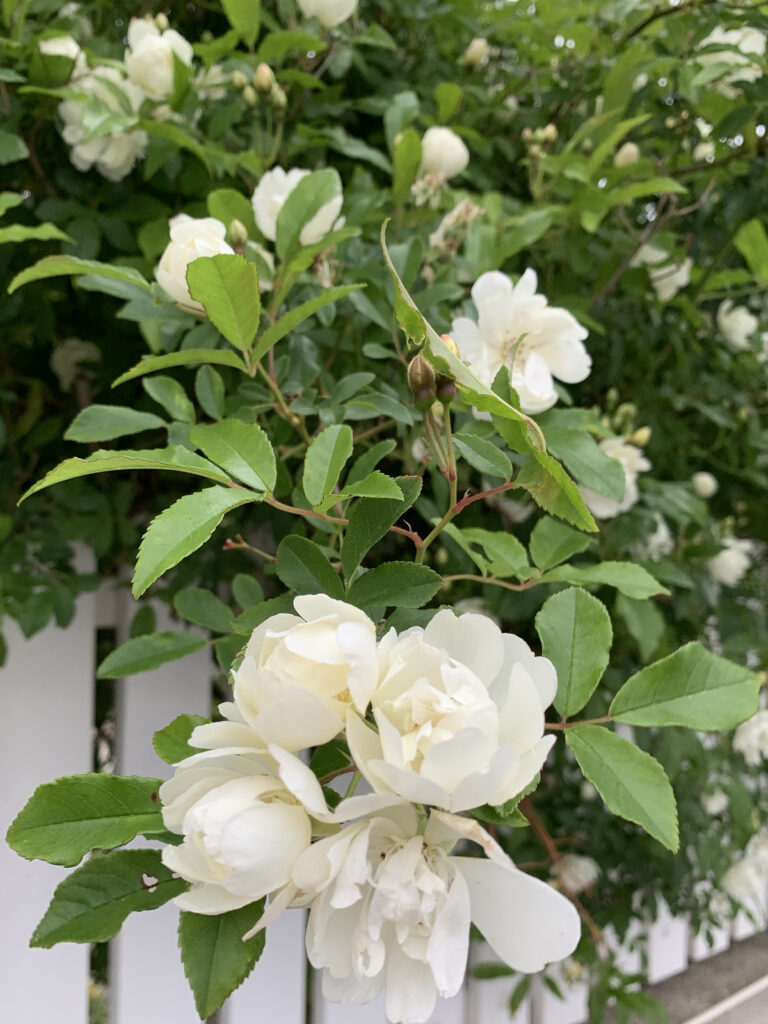
Which Rose for You?
To choose a rose, consider the following:
- What size rose can grow in your garden? Do you want a small rose or a tall rose?
- Where will the rose grow? Do you need a groundcover rose, a small or tall shrub rose, or a climber? Do you need roses for a hedge or a rose that will stand out as a specimen?
- When do you want blooms? Some roses bloom once in spring or summer, others repeat bloom spring into autumn.
- Will the rose you have in mind grow in your climate? Some roses grow best in hot summer regions, some grow best where summers are mild or cool.
- Now consider flower color and fragrance. (Not all roses are fragrant.)
Go to a nearby garden center or nursery and ask them to recommend a rose for you. A local garden center or nursery will stock or order roses that will grow where you live. Ask them for a rose that has been a best seller or a perennial favorite in your area; this will ensure you choose a rose that will thrive in your garden.
Get to know roses if you plant to grow roses. The more you know about roses, the more you will enjoy roses.
Old Garden Roses
Here are the commonly referenced classes or categories of old garden roses. These classes were in existence before 1867.

Alba: Large free-branching shrub roses with long canes, gray-green foliage; a few prickles on the stems; semidouble or double scented flowers generally white or pale pink; 5 to7 flowers per cluster; blooms spring to midsummer; blooms on second-year wood; once flowering; hardy, does not like hot summers, need cold winters; good for border and specimen planting. Varieties include ‘Great Maiden’s Blush’.
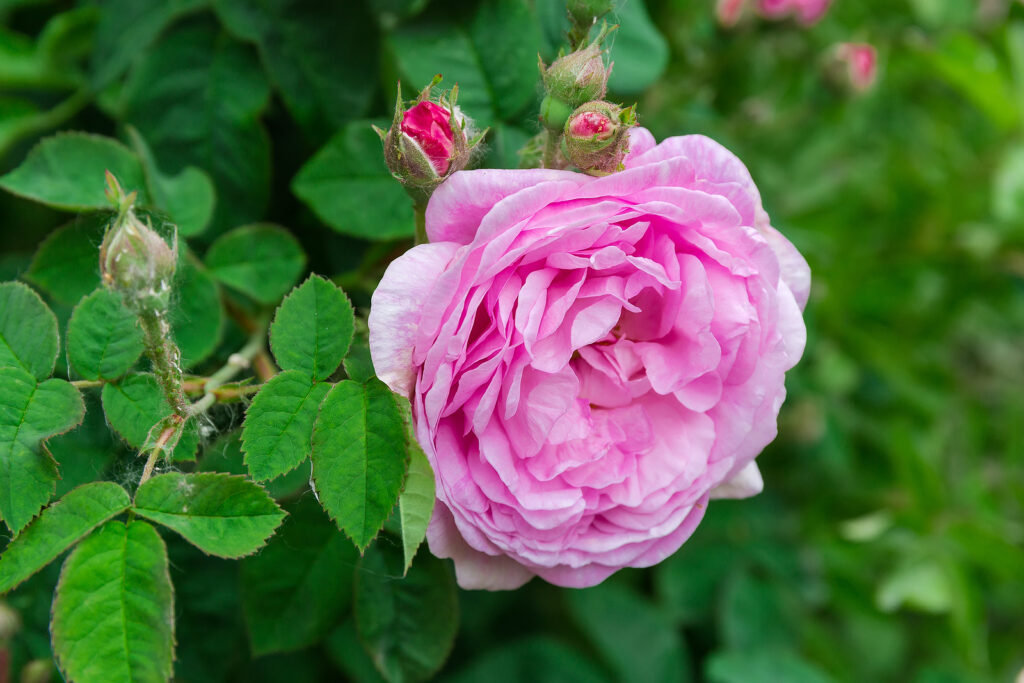
Bourbon: Loosely branched and open shrub rose with long arching canes; smooth or prickly stems; usually double fragrant flowers, produced in clusters of three; blooms summer and fall; repeat-flowering; blooms on second-year wood; good for borders, can be trained as a climber for growing on fences, walls, stakes, and pillars; cold-tolerant, struggle in Zone 8 and warmer. Varieties include ‘Boule de Neige’, ‘Kronpricessin Viktoria’, ‘Louise Odier’, ‘Madame Isaac Pereire, ‘Souvenir de la Malmaison’, ‘Zéphirine Drouhin’.
Boursault: climbing rose with long arching stems; dark green leaves on smooth stems; bear semi-double or doubles, slightly scented flowers, singly or in a cluster of 3; blooms spring or early summer on second-year wood; use against a sheltered wall or fence.
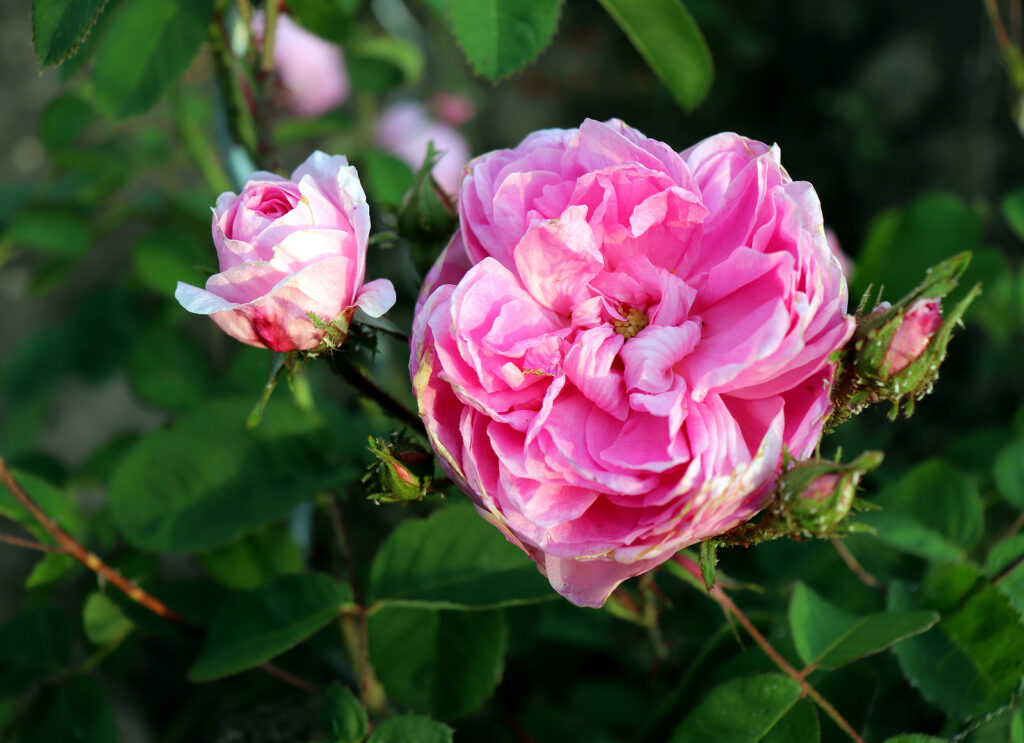
Centifolia (also called Provence rose or cabbage rose): loose, thorny shrub rose with dark green leaves; scented double flowers usually solitary or in a cluster of three; often have more than 100 petals—so sometimes referred to as “cabbage roses”; blooms in summer; once-blooming; blooms on second-year wood; good for borders. Varieties include ‘Rose de Meaux’ and ‘Shailer’s Provence’.
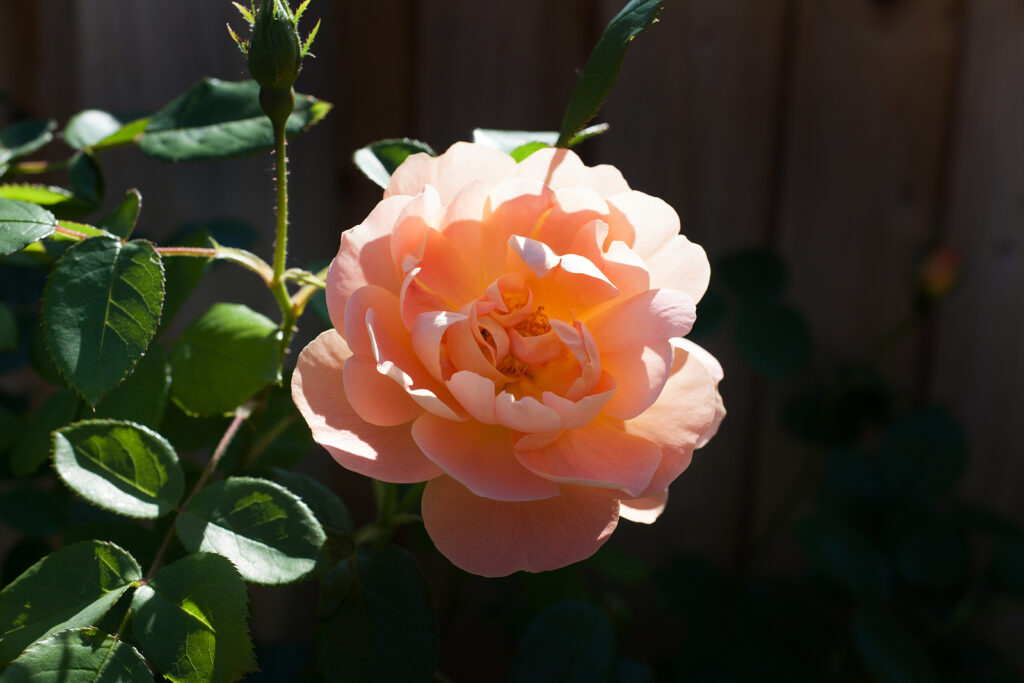
China: sparsely branched shrub rose with smooth stems and pointed, glossy leaflets; single or double flowers, sometimes scented, are solitary or in clusters of 2 to 13; blooms in summer; repeat-blooming; blooms on second-year wood; good for sheltered borders and walls; difficult to grow in regions colder than Zone 7. Varieties include ‘Archduke Charles’, ‘Cramoisi Supéieur’, ‘Green Rose’, ‘Louis Philippe’, ‘Mutabilis’, ‘Old Blush’. The Chinese rose is believed to have arrived in Sweden from China in 1752.
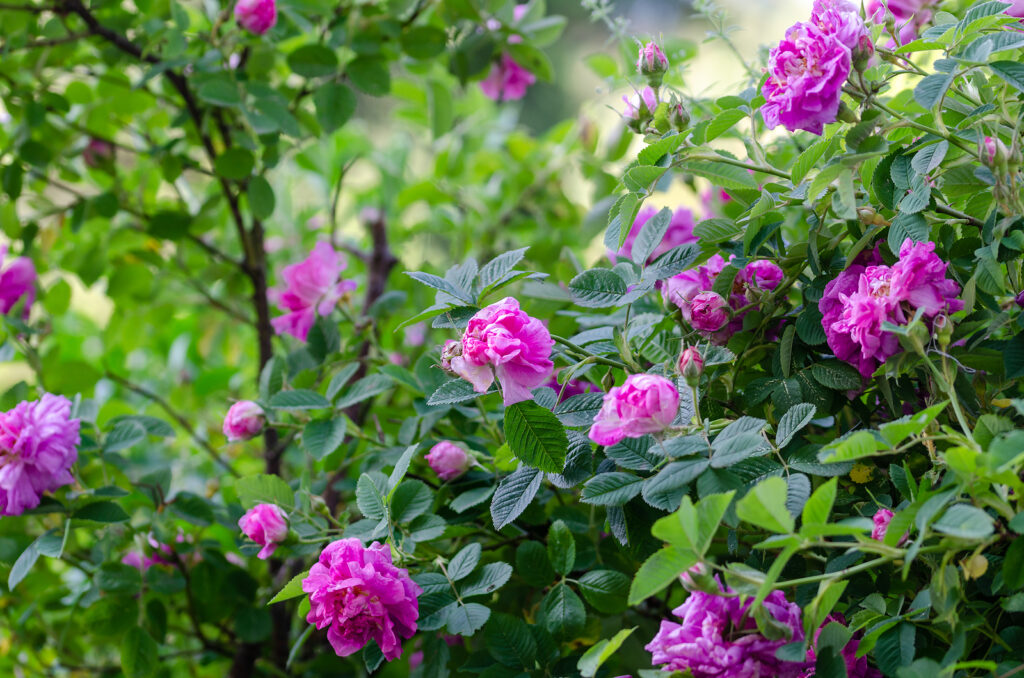
Damask: open, lax shrub rose with prickly stems; semidouble to double, intensely fragrant flowers, usually white, pink, or red; solitary or in loose clusters of 5 to 7 flowers; blooms in spring or early summer; once-blooming damasks are known as “summer damasks”; repeat-blooming damasks are known as “autumn damasks”; good for borders. Varieties include ‘Madame Hardy’, ‘Quatre Saisons’, ‘Rose de Rescht’. Cultivated in the eastern Mediterranean as early as the fifth century B.C.

Eglanteria: vigorous, free-branching shrub rose with usually prickly stems; sweetly scented single or double flowering bloom in singly or in clusters of up to 7; blooms in summer; blooms on second-year wood; use as hedges or specimen plant or in large borders.
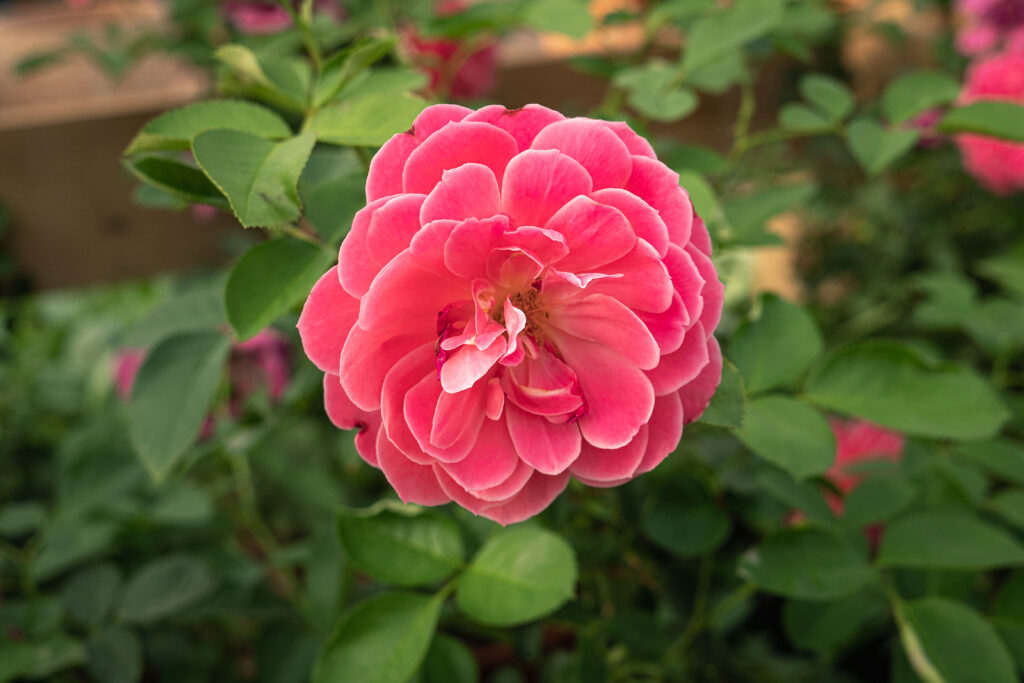
Gallica: dense, free branching shrub rose 4 to 5 feet tall with dull green leaves; leaf out late in spring; prickly canes and stems; bear single or double, richly colored pink, red or purple, scented flowers usually in threes; blooms in early summer; blooms once; blooms on second-year wood; cold hardy to Zone 4b; good for accents, borders, mass plantings, and hedging; varieties include ‘Charles de Mills’, ‘Belle de Crécy’, ‘Rosa Mundi’. Originated as a wild rose in central and southern Europe and western Asia in ancient times.
Hybrid Perpetual: vigorous freely branching upright shrub roses with prickly stiff canes and olive green leaves; scented flowers solitary, double, or in clusters of three; large flowers are usually pink or red, sometimes white; blooms in summer or fall; repeat-blooming; blooms on second-year wood; cold-hardy with little protection to Zone 5b; good for beds and borders. Varieties include ‘Baronne Prévost’, Frau Karl Druschki’, ‘La Reine’, ‘Marchessa Bpccella’, ‘Reine des Violettes’.
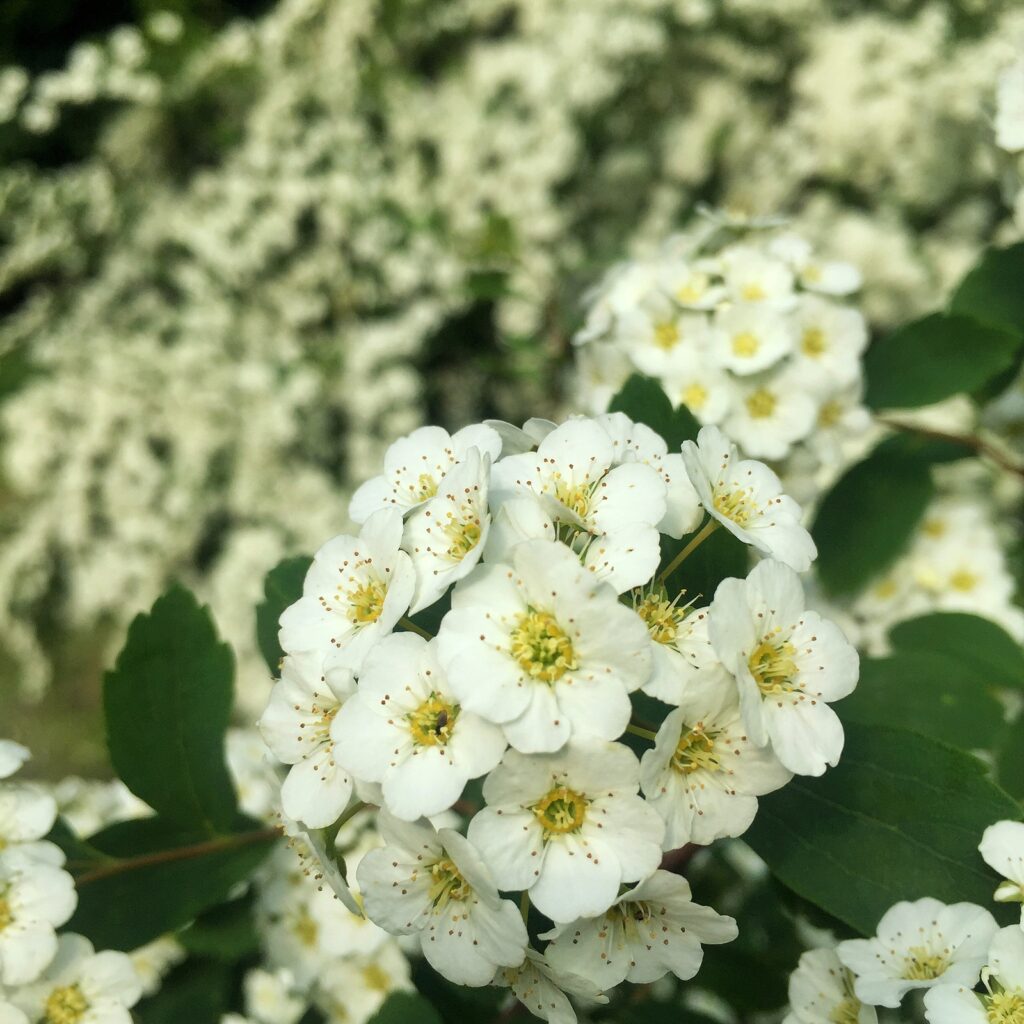
Hybrid Sempervirens: semi-evergreen climber or rambler rose with glossy, bright pale to mid-green leaves; arching, prickly stems; bear clusters of 3 to 15 unscented semidouble or double flowers; blooms in late summer; blooms on second-year wood; good for pergolas, fences, and informal naturalizing.
Hybrid Spinosissima: suckering shrub rose with a low, spreading habit, rarely upright; single to double, occasionally scented single or double flowers borne singly or in clusters of 3 or more; summer blooming; blooms on second-year wood; use in a bed or border.
Moss: loosely branched shrub rose with mosslike, fuzzy growth on thorny stems and buds, dark green leaves; fragrant semidouble or double flowers in clusters of 3 or more; blooms in spring or early summer; mostly once-blooming blooms on second-year wood; use in beds and borders. Varieties include ‘Crested Moss Rose’.
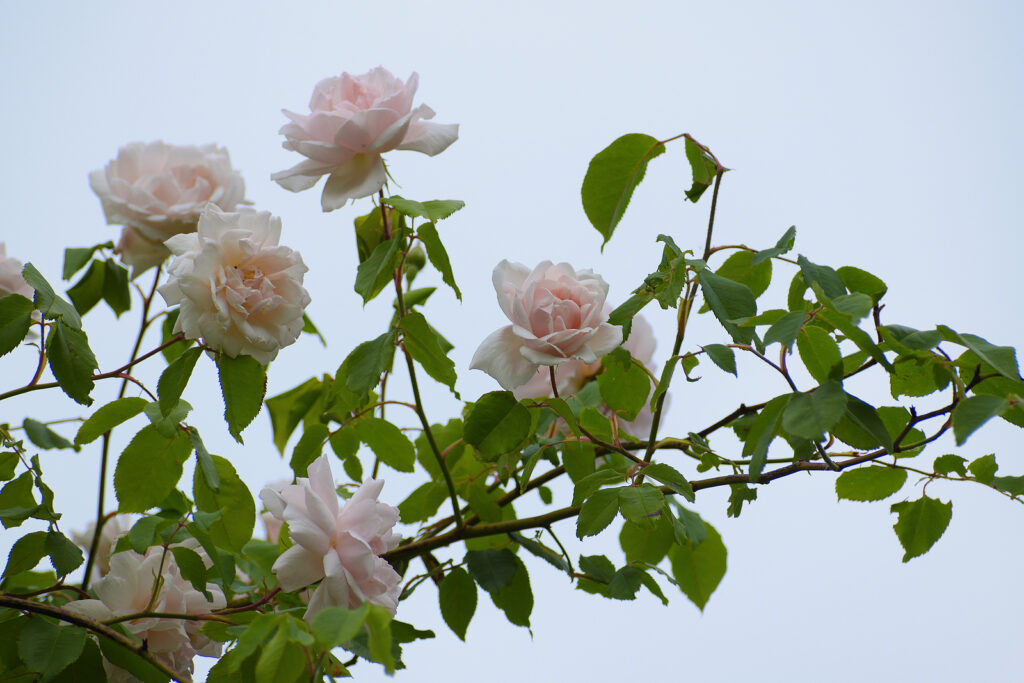
Noisette: large, sprawling or climbing shrub rose with smooth stems and glossy leaves; usually, double flowers are spice-scented; 3 to 15 flowers per clusters; blooms summer and fall; repeat-blooming; flowers on second-year wood; cold tender only to Zone 7b; good for sheltered, warm walls. Varieties include ‘Blush Noisette’, ‘Céline Forestier’, ‘Madame Alfred Carriè, ‘Maréchal Niel’. These were the first roses developed in the United States in South Carolina dating to about 1802.
Portland (sometimes called Damask Perpetual): upright, compact shrub rose with prickly stems; fragrant flowers are semidouble or double, solitary or in clusters of three; blooms in summer and fall; repeat-blooming; blooms on second-year wood; good for beds and borders.
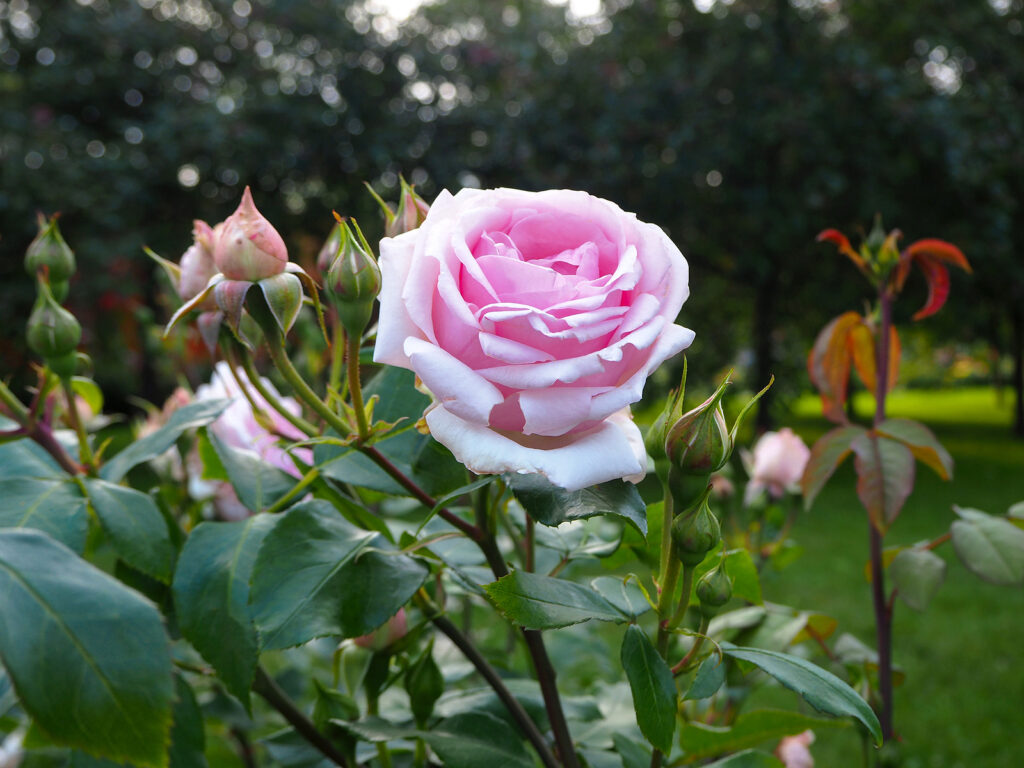
Tea and Climbing Tea: shrub rose to 6 feet tall and climbing rose with smooth or prickly stems; glossy, pale green leaves; semidouble and double spice-scented flowers on slender stems, solitary or in clusters of three; flowers tend to droop on stems; flowers are in light yellow, pink, or white range borne on canes with few thorns; blooms from spring to fall; repeat-flowering; blooms on second-year wood; best in Zones 7 and warmer; good for sheltered borders. Varieties include ‘ Baronee Henriette de Snoy’, ‘Duchesse de Brabant’, ‘Madame Lombard’, ‘Monsieur Tillier’, ‘Sombreuil’, ‘William R. Smith’. Dependable roses in Zones 8,9, 10. Arrived in England from China in 1809 with a load of tea—thus the name tea rose.
Modern Roses
Modern roses number many thousands of cultivars. They are varied in size and shape and bloom time. Here are commonly referenced categories or classes of modern roses.
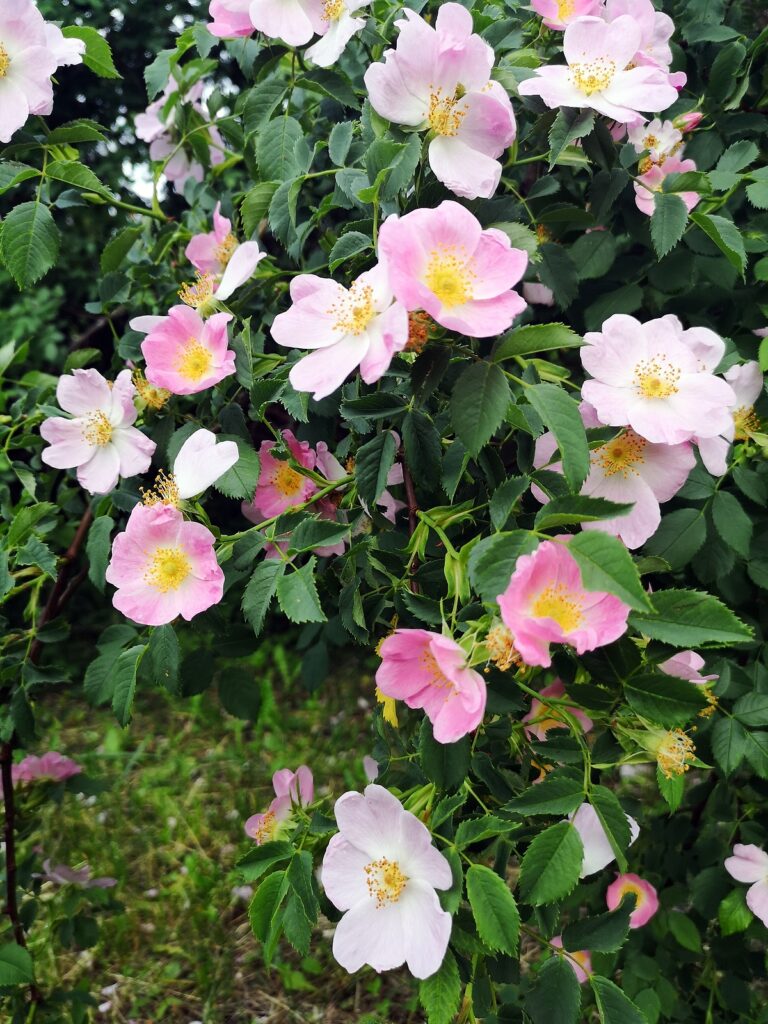
Climber (this group includes climbing hybrid tea, climbing floribunda, climbing grandiflora, hybrid wichurana, large-flowered climber, and climbing miniatures): vigorous climber roses with arching rather rigid stems; arching canes need some type of support; single or double flowers are solitary or in clusters of 3 to 7 or more; blooms from late spring to fall; repeat-blooming; blooms on second-year wood; good for wall, fences, and pergolas. Varieties include ‘Altissimo’, ‘America’, ‘Cherokee’, ‘Don Juan’, ‘Lady Banks, Yellow’, ‘New Dawn’, ‘Silver Moon’.
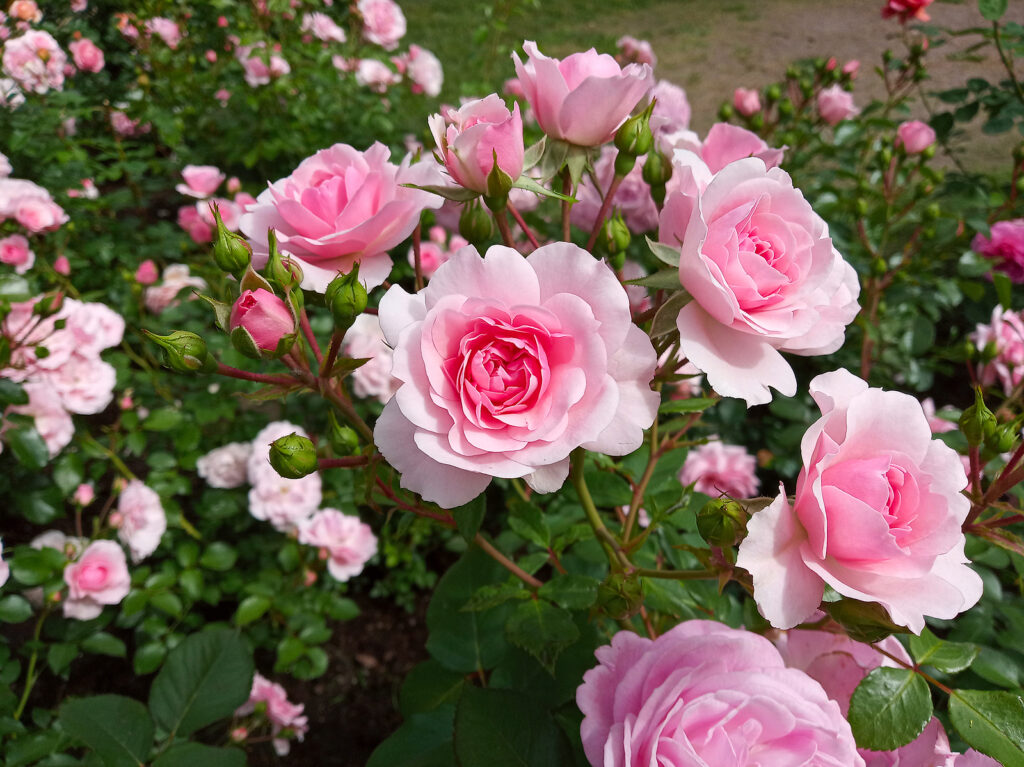
Floribunda: vigorous, free-flowering upright shrub rose, usually with prickly stems; flowers single or double scented flowers, 3 to 25 per spray; blooms in summer and fall; near-continuous blooms; blooms on second-year wood; hardier than hybrid teas; good for borders and hedges. Varieties include ‘Betty Prior’, ‘Europeana’, ‘French Lace’, ‘Iceberg’, ‘Livin’ Easy’, ‘Nearly Wild’, ‘Playboy’, ‘Sunsprite’
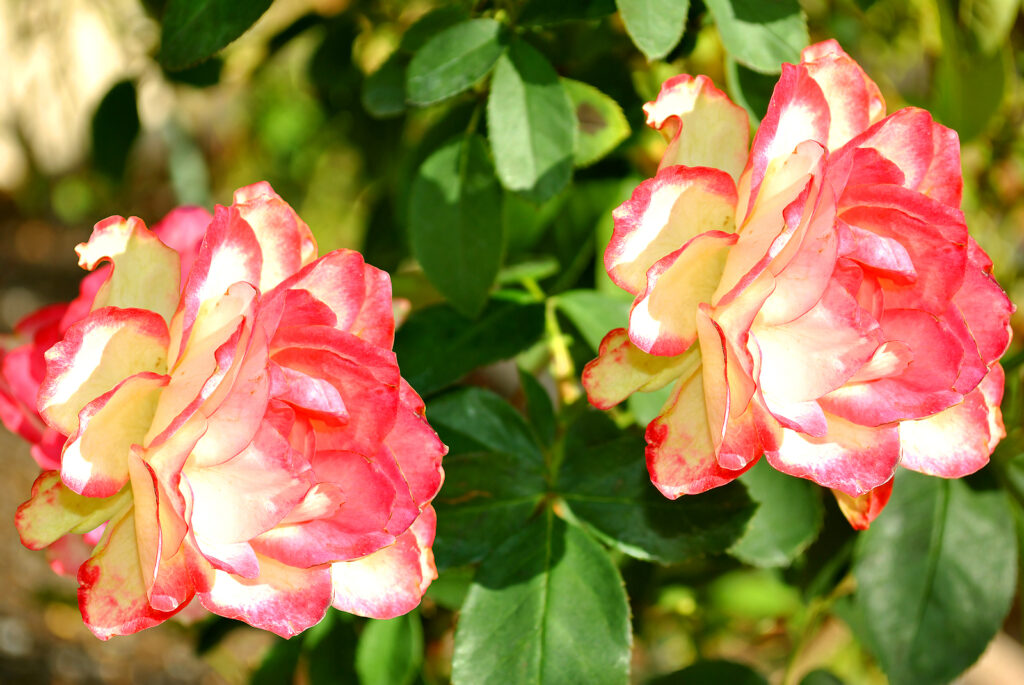
Grandiflora: rather tall rose similar to hybrid tea; large flowers on long stems produced singly or in clusters, smaller cluster than floribundas; hardier than hybrid teas. Varieties include ‘Caribbean’, ‘Queen Elizabeth’. ‘Pink Parfait’, ‘Tournament of Roses’.
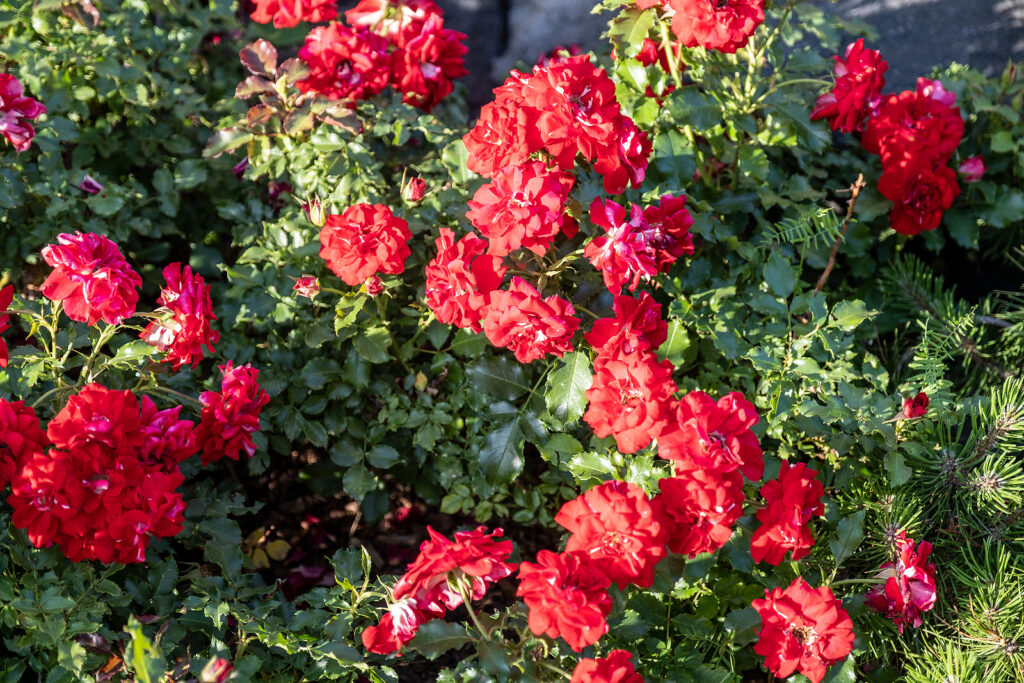
Groundcover: spreading and trailing shrub rose; prickly stems are long and trailing, more or less prostrated; single or double sometimes scented flowers in clusters of 3 to 11 flowers; blooms in summer and fall; repeat-blooming; blooms on second-year wood; many bear flowers all along the stems; good for low to medium groundcover under shrubs and for beds, banks, and trailing over walls.

Hybrid Musk: large growing shrub rose with arching canes; large clusters of small- to medium-size flowers that are fragrant in warm, humid weather; repeat bloomers in summer. Varieties include ‘Ballerina’, ‘Buff Beauty’, ‘Penelope’.

Hybrid Rugosa, sometimes known as Japanese roses: hardy shrub rose with prickly stems; most bear single or semi-double scented flowers in clusters of 3 to 11; blooms throughout summer and autumn; blooms on second-year wood and on new wood; usually has red hips (seedpods); use as hedge or bed and border or as a specimen plant. Varieties include ‘Belle Poitevine’, ‘Frau Dagmar Hastrup’, ‘Henry Hudson’, ‘Schnezwerg’.
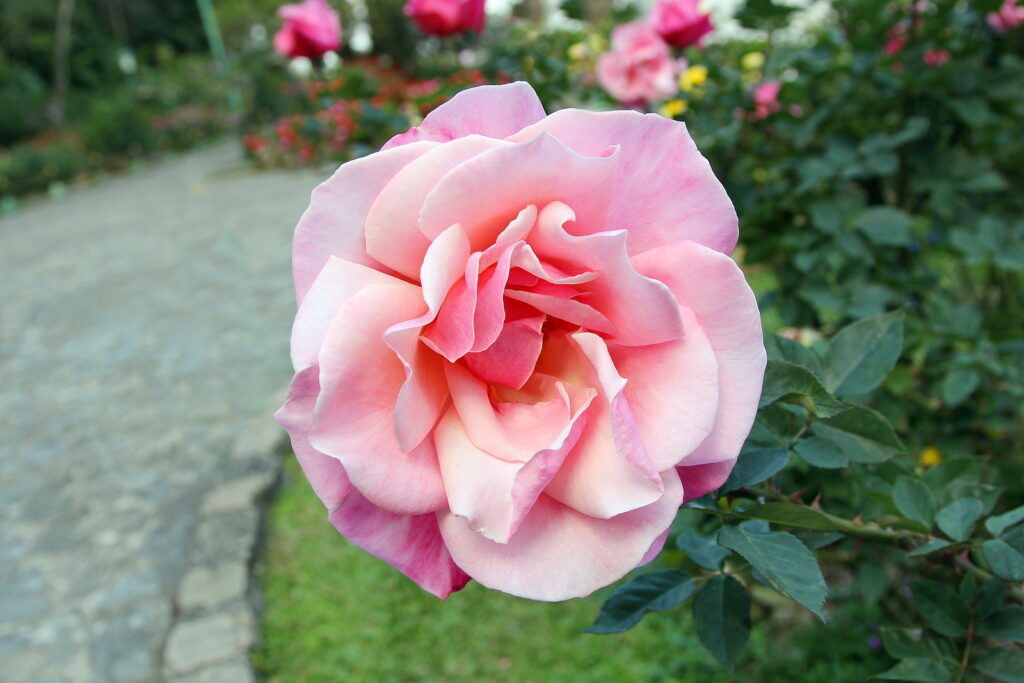
Hybrid Tea: vigorous, upright, narrow shrub rose usually 3 to 5 feet all with prickly stems; long-stemmed usually double scented flowers, generally one per stem, sometimes borne in a cluster of 3 to 6; blooms summer to fall; flush of flowers every 6 weeks or so; blooms on second-year wood; good for borders, hedges, and formal gardens; this is the classic rose used for cut flowers. Varieties include ‘Antoine Rivoire’, ‘Dainty Bess’, ‘Double Delight’, ‘First Prize, ‘Fragrant Could’, ‘Lafter’, ‘Mister Lincoln’, ‘Olympiad’, ‘Peace’, ‘Radiance’ ‘Touch of Class’.

Miniature: dwarf bush rose usually 6 to 24 inches tall; with proportionally small leaves and flowers; single or double flowers, 3 to 11 flowers per spray; rarely scented; repeat-blooming; beds, edging paths, containers, and small gardens. Varieties include ‘Jeanne Lajoie’, ‘Minnie Pearl’, ‘Starina’.
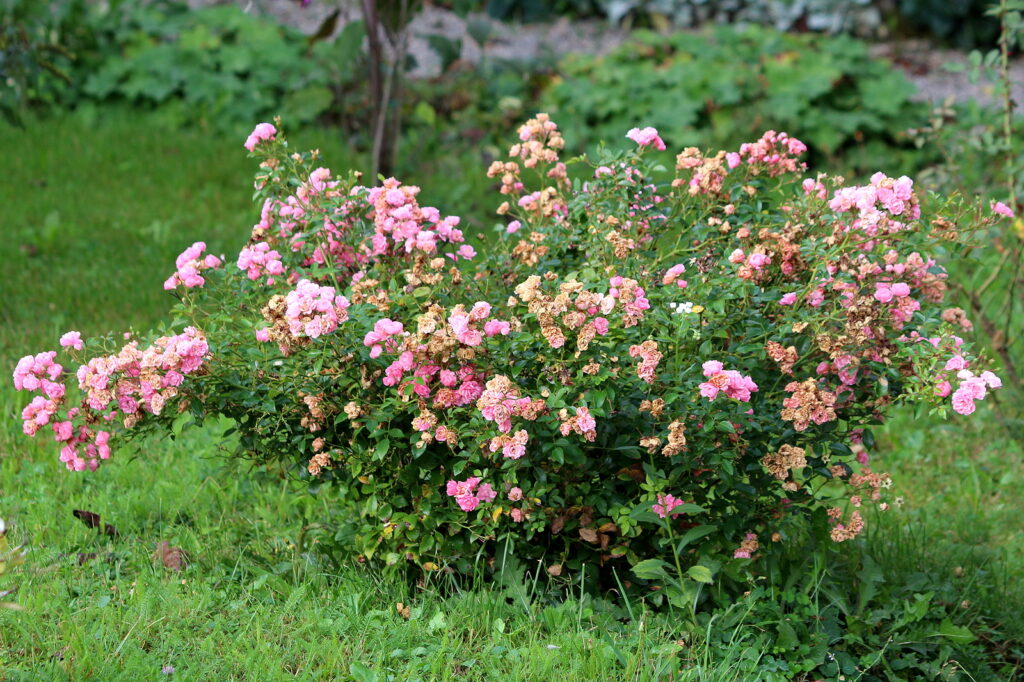
Patio (dwarf Floribunda): small compact shrub (24 x 24 inches/60x60cm); single or double flowers, 3 to 11 flowers per cluster; blooms summer and fall; good for beds, edging paths, and containers.
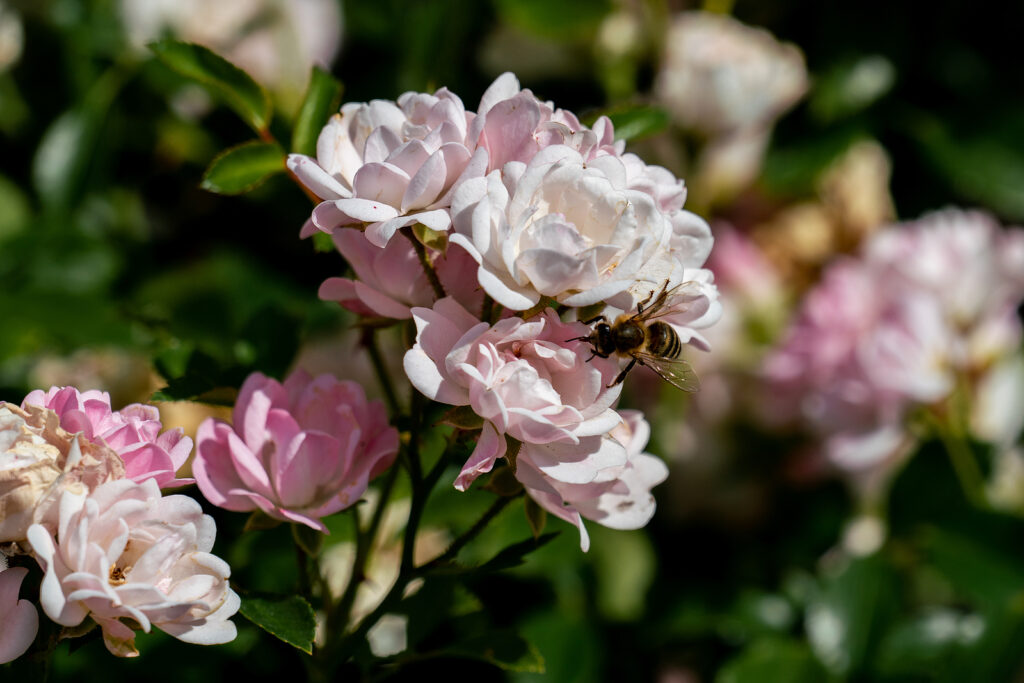
Polyantha: compact, resilient small to medium-size shrub rose with prickly stems; small single or double flowers, 7 to 15 flowers per spray; blooms in summer and fall; blooms on second-year wood and on new wood; repeat-blooming; grows best in Zones 6 to 10; good for borders, hedges, and containers. Varieties include ‘Cécile Brunner’, ‘China Doll’, Climbing Pinkie’, ‘The Fairy’.
Rambler: climbing roses with robust, lax stems; single or double flowers in clusters of 3 to 21; blooms in summer; good for wall, pergolas, and trees; roses in this group are now included in the climber group
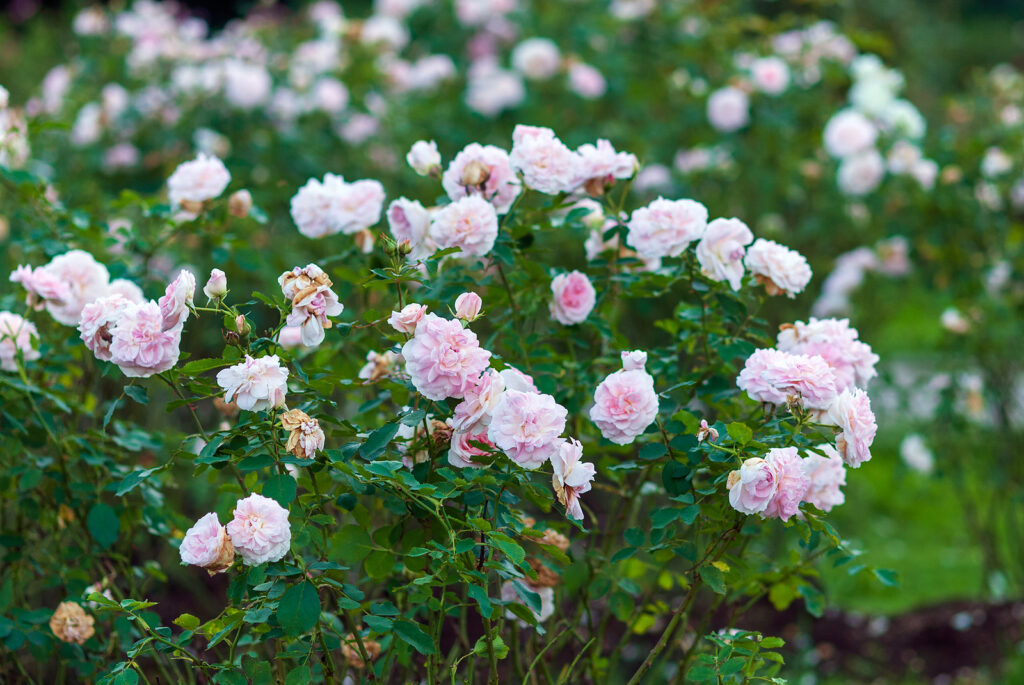
Shrub: This is a large group containing several classes including the hybrid kordesii hybrid moyesii, hybrid musk, hybrid rugosa, and other shrubs; this group also includes English or Austin roses which were hybridized in England by rose breeder David Austin. Roses usually taller than hybrid tea roses; usually scented single or double flowers, solitary or in sprays; blooms in summer and fall; blooms on second-year wood; good for beds and specimen planting. David Austin varieties include ‘Belle Story’, ‘Graham Thomas’, ‘Heritage’, ‘Mary Rose’, ‘Tamora’, ‘The Wife of Bath’.
Also of interest:















